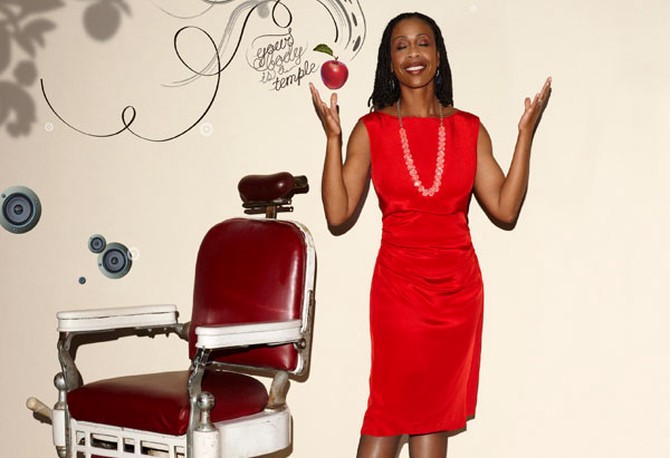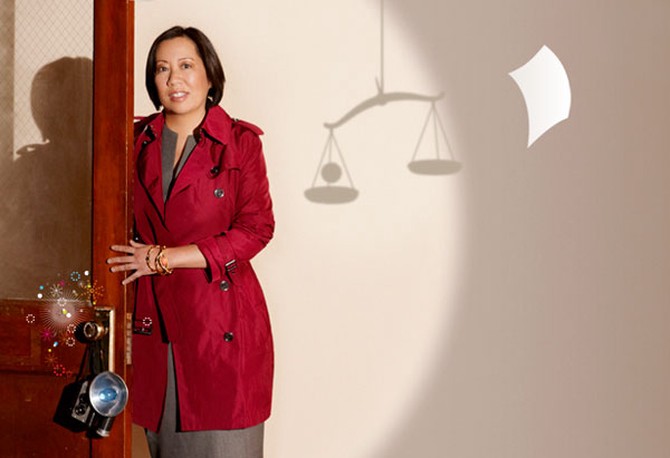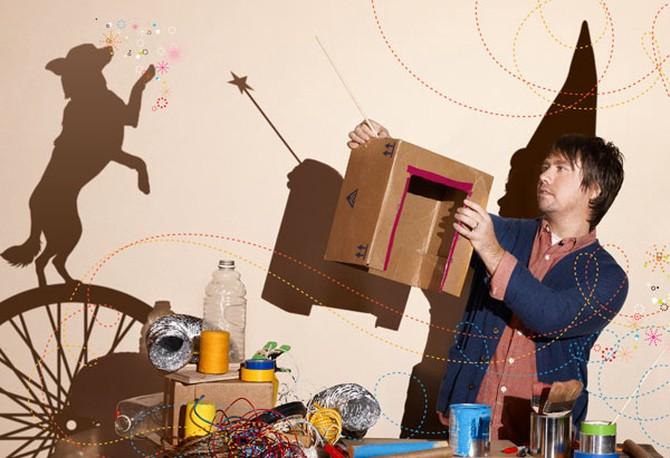You Don't Need to Be an Artist to Have Imagination
Four people whose knack for innovation has helped them make astonishing things.

Photograph: William Abromowicz/Illustration: Oksana Badrak
Michelle Khine: The Reinventor
When Michelle Khine throws a dinner party, dessert might be cake wrapped in electroluminescent wires, or homemade coconut ice cream frozen instantly in a bowl of liquid nitrogen. "Growing up, I was a nerdy kid who loved to experiment in the kitchen," says Khine, 34, whose mom—a chemist—taught her how to cook.
It's fitting, then, that Khine's kitchen provided the stage for the niftiest feat of her career. She had just landed a research job at the brand-new University of California campus at Merced, which was little more than a construction site. She'd intended to work with microfluidic chips—silicon circuits that scientists want to develop into bedside tests for diseases—but she didn't have a lab. Puttering around her kitchen one day, she remembered her favorite childhood toy: Shrinky Dinks, the sheets of plastic that kids decorate with paint, pens, or colored pencils, then bake. After a trip to a crafts store and with the help of a laser printer and a toaster oven, Khine created her own Shrinky Dink "lab on a chip": an improbably viable alternative to high-grade silicon devices made with multimillion-dollar equipment. She later developed Shrinky Dink–based tools for culturing stem cells to grow new heart tissue, and hopes her chips will someday be used in supercheap diagnostic tests for patients in the developing world.
"I try to think about things very simply," says Khine, now an assistant professor at UC Irvine. "When my students get stuck, I tell them to stop making things complicated and pare it down to first principles." For Khine, getting unstuck means taking a break—preferably in the company of her petite black Labrador mix, whom her students have nicknamed MicroLab. "My best inspiration and ideas come when I'm walking the dog or driving or taking a shower," she says. "If I let a problem simmer long enough, something clicks."
—Aaron Rowe
It's fitting, then, that Khine's kitchen provided the stage for the niftiest feat of her career. She had just landed a research job at the brand-new University of California campus at Merced, which was little more than a construction site. She'd intended to work with microfluidic chips—silicon circuits that scientists want to develop into bedside tests for diseases—but she didn't have a lab. Puttering around her kitchen one day, she remembered her favorite childhood toy: Shrinky Dinks, the sheets of plastic that kids decorate with paint, pens, or colored pencils, then bake. After a trip to a crafts store and with the help of a laser printer and a toaster oven, Khine created her own Shrinky Dink "lab on a chip": an improbably viable alternative to high-grade silicon devices made with multimillion-dollar equipment. She later developed Shrinky Dink–based tools for culturing stem cells to grow new heart tissue, and hopes her chips will someday be used in supercheap diagnostic tests for patients in the developing world.
"I try to think about things very simply," says Khine, now an assistant professor at UC Irvine. "When my students get stuck, I tell them to stop making things complicated and pare it down to first principles." For Khine, getting unstuck means taking a break—preferably in the company of her petite black Labrador mix, whom her students have nicknamed MicroLab. "My best inspiration and ideas come when I'm walking the dog or driving or taking a shower," she says. "If I let a problem simmer long enough, something clicks."
—Aaron Rowe

Photograph: William Abromowicz/Illustration: Oksana Badrak
Carla Boutin-Foster: The Listener
Carla Boutin-Foster, MD, had hit a wall. In the spring of 2007, she was leading a weekly series of safe-sex talks with middle school girls in Brooklyn. But the students kept leaving to "use the bathroom"—and not coming back. After week three,the doctor had an idea: Follow them.
"I found the girls in the cafeteria, listening to rap songs about drugs and sex," she recalls. For the next class, Boutin-Foster brought a stereo. "I asked them, 'When 50 Cent says, Find me in da club, bottle full of bub...I'm into having sex, I ain't into making love—what can that lead to?'" The girls were suddenly interested. They talked about safe sex and STDs, behavior and consequences. The conversation led to a pilot program to teach disease prevention through rap at an East Harlem school.
Boutin-Foster, 42, is the director of the Comprehensive Center of Excellence in Disparities Research and Community Engagement (CEDREC) at Weill Cornell Medical College, which works to improve healthcare in underserved neighborhoods of New York City; in one CEDREC project, a medical van tours barbershops offering free on-site diabetes and blood pressure screenings. The daughter of Haitian immigrants ("Mom would buy secondhand shoes and pin brooches on top—she was creative"), she is fluent not only in hip-hop slang but in the poetry of scripture—which comes in handy when she leads health workshops at churches. "The Bible doesn't say, 'Thou shalt not smoke,' but First Corinthians says, 'I will not be mastered by anything.' So we discuss ways not to be mastered by cigarettes and junk food."
For Boutin-Foster, being creative means being receptive. "It's about listening and following and finding a common language," she says. "And sometimes it helps to hit a wall."
—Kimberly Hiss
"I found the girls in the cafeteria, listening to rap songs about drugs and sex," she recalls. For the next class, Boutin-Foster brought a stereo. "I asked them, 'When 50 Cent says, Find me in da club, bottle full of bub...I'm into having sex, I ain't into making love—what can that lead to?'" The girls were suddenly interested. They talked about safe sex and STDs, behavior and consequences. The conversation led to a pilot program to teach disease prevention through rap at an East Harlem school.
Boutin-Foster, 42, is the director of the Comprehensive Center of Excellence in Disparities Research and Community Engagement (CEDREC) at Weill Cornell Medical College, which works to improve healthcare in underserved neighborhoods of New York City; in one CEDREC project, a medical van tours barbershops offering free on-site diabetes and blood pressure screenings. The daughter of Haitian immigrants ("Mom would buy secondhand shoes and pin brooches on top—she was creative"), she is fluent not only in hip-hop slang but in the poetry of scripture—which comes in handy when she leads health workshops at churches. "The Bible doesn't say, 'Thou shalt not smoke,' but First Corinthians says, 'I will not be mastered by anything.' So we discuss ways not to be mastered by cigarettes and junk food."
For Boutin-Foster, being creative means being receptive. "It's about listening and following and finding a common language," she says. "And sometimes it helps to hit a wall."
—Kimberly Hiss

Photograph: William Abromowicz/Illustration: Oksana Badrak
Jane Sujen Bock: The Justice Seeker
Sitting among the law books in Jane Sujen Bock's Manhattan office is a plastic bag full of paint chips: a keepsake from a successful case, and proof of an inventive legal mind at work. In 2002, Bock, an attorney with the Homeless Rights Project of the Legal Aid Society, learned that the city was using the Bronx House of Detention as a homeless shelter. "The ventilation was horrible, and kids were having asthma attacks," she says. "Not to mention the emotional damage to children who were being told that this"—living in a jail—"was what they were worth."
Bock could have built a case for relocating the kids, which would have taken years to wind through the court system. But she wanted a solution now. She visited the jail and, suspecting that the facility wasn't up to code, peeled a few flakes off the walls. Sure enough, tests revealed that the place was coated in lead paint; within weeks, hundreds of families had been moved to safer, more humane shelters—and the story had hit the front page of The New York Times.
"Traditional legal tactics often don't work well for poor people," says Bock, 51, one of just two lawyers tasked with helping 10,000 homeless families in New York City. "They're up against massive bureaucracies, and the court system is very slow." So Bock recruits pro bono advocates to push for legislation; she tips off the press to injustices and brings clients to testify at city council hearings; she's even been known to shadow vans transporting homeless families to collect affidavits about inadequate shelters. Her enterprising approach means that, on any given day, Bock is not just a lawyer but a social worker, detective, community activist, and building inspector—in addition to being a mother of two with a deep empathy for her clients. "I see homeless mothers who are being so creative in trying to provide for their children when they have lost their jobs, or have been battered, or have had their ceilings fall down on their heads," she says. "I'll do whatever I can to give these kids a chance." The proof is in the plastic bag.
—Raha Naddaf
Bock could have built a case for relocating the kids, which would have taken years to wind through the court system. But she wanted a solution now. She visited the jail and, suspecting that the facility wasn't up to code, peeled a few flakes off the walls. Sure enough, tests revealed that the place was coated in lead paint; within weeks, hundreds of families had been moved to safer, more humane shelters—and the story had hit the front page of The New York Times.
"Traditional legal tactics often don't work well for poor people," says Bock, 51, one of just two lawyers tasked with helping 10,000 homeless families in New York City. "They're up against massive bureaucracies, and the court system is very slow." So Bock recruits pro bono advocates to push for legislation; she tips off the press to injustices and brings clients to testify at city council hearings; she's even been known to shadow vans transporting homeless families to collect affidavits about inadequate shelters. Her enterprising approach means that, on any given day, Bock is not just a lawyer but a social worker, detective, community activist, and building inspector—in addition to being a mother of two with a deep empathy for her clients. "I see homeless mothers who are being so creative in trying to provide for their children when they have lost their jobs, or have been battered, or have had their ceilings fall down on their heads," she says. "I'll do whatever I can to give these kids a chance." The proof is in the plastic bag.
—Raha Naddaf

Photograph: William Abromowicz/Illustration: Oksana Badrak
James Griffioen: The Super-Dad
My wife works while I stay home and take care of our two young children, plus Wendell, an energetic bird dog we rescued from the streets of Detroit. He loves to run but had to settle for meandering walks with short-legged toddlers until it hit me: I could build a dog wagon. With a flathead screwdriver and a lot of trial and error, I transformed our old jogging stroller into a sleek two-seat sulky. Now when Wendell hears me jangle the harness I built from old leather belts, he leaps into the air and bolts to the door—he can't wait to pull those kids from the farmers' market to the riverfront, and we travel at a pace that thrills us all.
I am not an engineer or any kind of craftsman. I'm a guy whose kids—and possibly his dog—still believe he can do anything. When I left my job as a corporate litigator four years ago, it was a promise to my children: I may not be able to buy you as many things, but you will know your father. We moved from tony San Francisco to downtown Detroit, where there aren't as many stores or things to do. We have to make our own fun.
So when we noticed a few inches of water had frozen in a deserted lot, we grabbed our ice skates and made it our own private rink. When my 5-year-old daughter became obsessed with ancient Egypt, we cut pizza boxes into pyramids and turned our living room into the Giza plateau. When my 2-year-old son wanted to be RoboCop for Halloween, we raided the recycling bin for detergent bottles and milk jugs and painted them metallic gray. I pieced his mask together from an old bike helmet and a wash bucket. We hit the streets in search of evildoers and commiserated with real Detroit cops who let my son sit behind the wheel of a real police car.
Creativity rubs off. Not long ago, my daughter asked me to build her a horse, and I made sure she was part of every step of the process that didn't involve power tools. She designed and helped craft her scrap-plywood Pegasus from the first sketches to the last coat of stain. Something that existed only in her imagination became a toy she could ride. Every project we finish feels like the fulfillment of a promise, though it's not the things we create that matter—it's the time we spend creating things together.
—James Griffioen
Feeling Inspired? Take the Un-Quiz, created by Miranda July.
I am not an engineer or any kind of craftsman. I'm a guy whose kids—and possibly his dog—still believe he can do anything. When I left my job as a corporate litigator four years ago, it was a promise to my children: I may not be able to buy you as many things, but you will know your father. We moved from tony San Francisco to downtown Detroit, where there aren't as many stores or things to do. We have to make our own fun.
So when we noticed a few inches of water had frozen in a deserted lot, we grabbed our ice skates and made it our own private rink. When my 5-year-old daughter became obsessed with ancient Egypt, we cut pizza boxes into pyramids and turned our living room into the Giza plateau. When my 2-year-old son wanted to be RoboCop for Halloween, we raided the recycling bin for detergent bottles and milk jugs and painted them metallic gray. I pieced his mask together from an old bike helmet and a wash bucket. We hit the streets in search of evildoers and commiserated with real Detroit cops who let my son sit behind the wheel of a real police car.
Creativity rubs off. Not long ago, my daughter asked me to build her a horse, and I made sure she was part of every step of the process that didn't involve power tools. She designed and helped craft her scrap-plywood Pegasus from the first sketches to the last coat of stain. Something that existed only in her imagination became a toy she could ride. Every project we finish feels like the fulfillment of a promise, though it's not the things we create that matter—it's the time we spend creating things together.
—James Griffioen
Feeling Inspired? Take the Un-Quiz, created by Miranda July.
From the February 2011 issue of O, The Oprah Magazine

